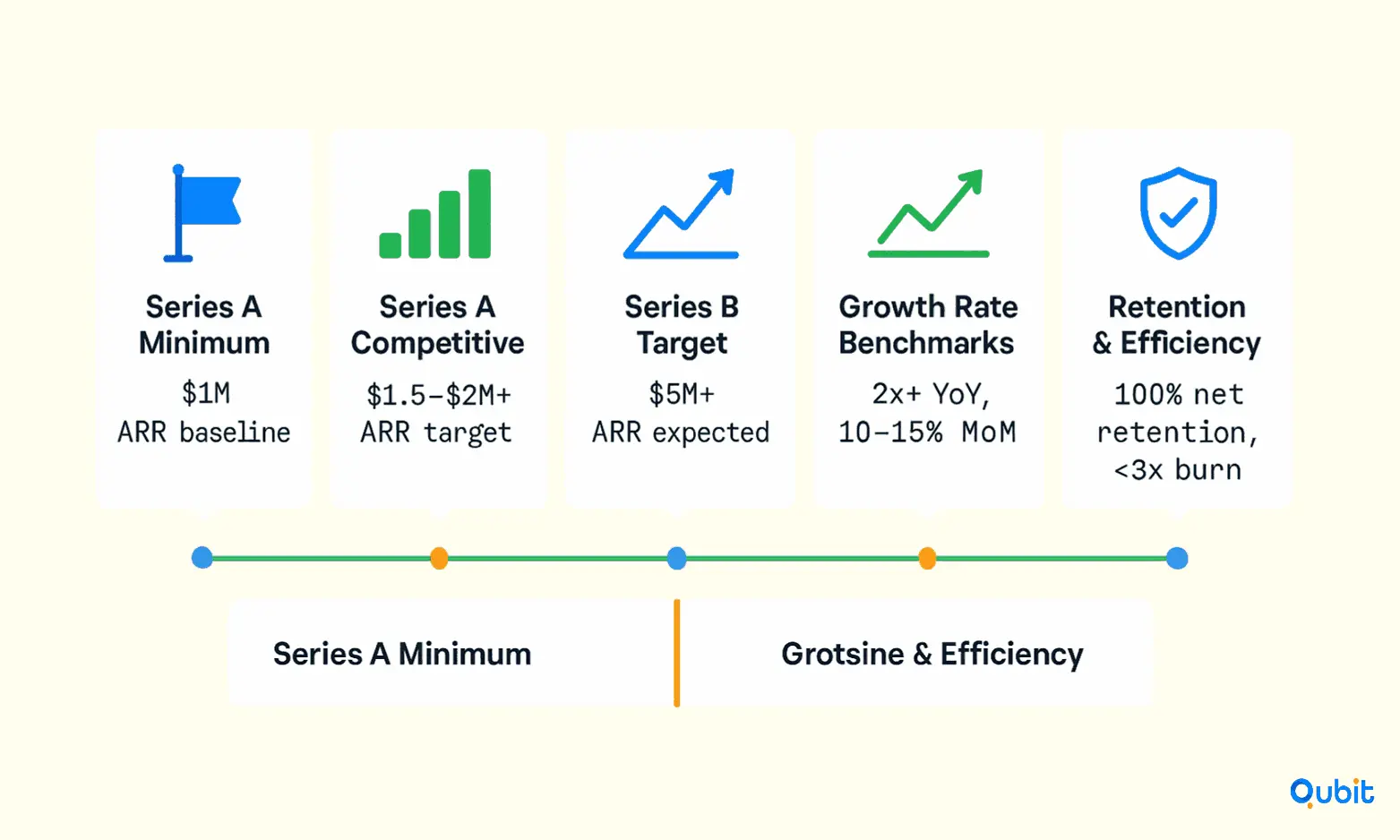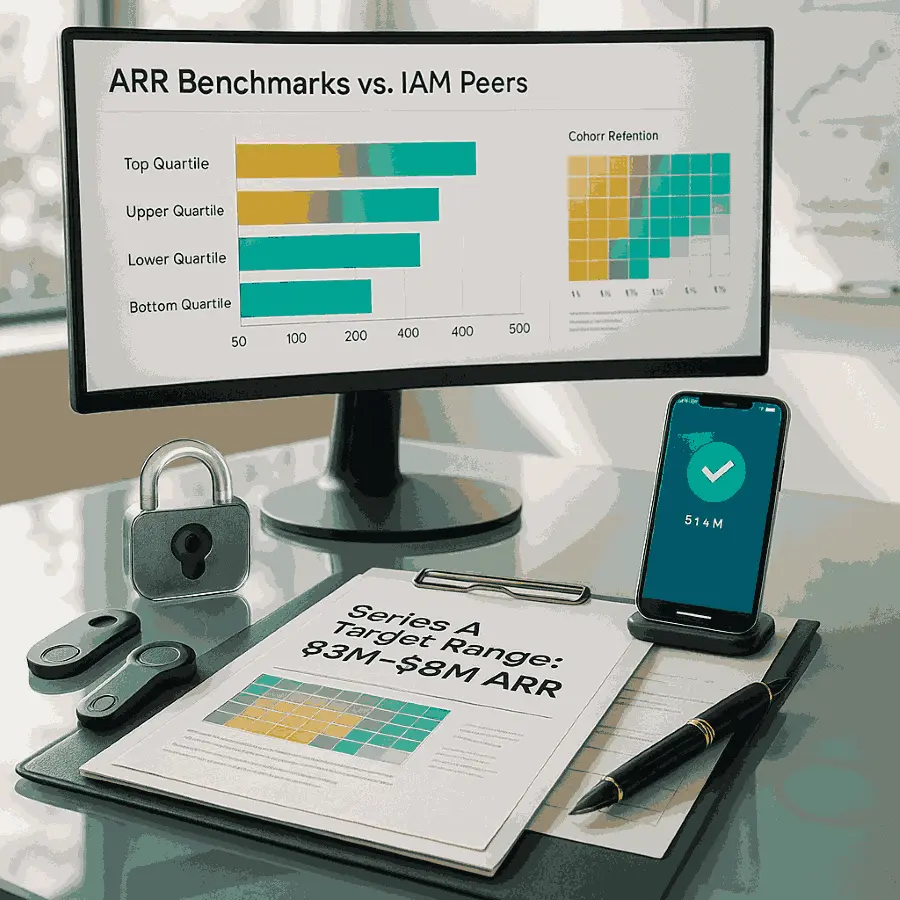For founders of Identity and Access Management (IAM) startups, Annual Recurring Revenue (ARR) benchmarks are pivotal for navigating the path to a successful Series A. Nowadays venture climate, investors are more data-driven and discerning than ever, scrutinizing not just topline ARR, but also growth rates, retention, and capital efficiency.
This guide synthesizes the latest benchmarks, market expectations, and actionable strategies to help IAM founders calibrate their fundraising journey, with practical insights and internal links to deepen your understanding of the broader cybersecurity funding landscape.
Why ARR Matters for IAM Startups
ARR is the definitive metric for SaaS and IAM startups. It encapsulates the predictability and scalability of your business model, serving as a proxy for product-market fit, customer validation, and future growth potential. For IAM founders, demonstrating robust ARR is not just about hitting a number, it’s about signaling market traction in a sector where trust, compliance, and mission-criticality are paramount.
Fundraising across cybersecurity verticals involves diverse deal structures and investor criteria. The cybersecurity startup fundraising guide walks through the capital models, growth-stage expectations, and trend insights founders need across network security, application protection, and beyond.
The Evolving Series A ARR Benchmark: Where Do You Stand?

The Historical Baseline: $1M ARR
Traditionally, the $1 million ARR milestone has been viewed as the “magical number” for Series A fundraising in SaaS and IAM. This figure has long been associated with achieving product-market fit and demonstrating that your solution has repeatable, scalable demand.
“Series A is the product-market fit round. $1M in ARR is the magical number that equals product-market fit.”
The New Reality: $1.5M–$2M+ ARR
Recent data shows that the bar for Series A has risen. Investors are now looking for ARR north of $1M, often closer to $1.5M or even $2M for IAM and B2B SaaS startups. This shift reflects a more competitive venture environment, higher expectations for growth velocity, and the maturation of the SaaS/IAM market.
- Median ARR for Series A: $1.5M–$2M is increasingly common, especially in crowded or mature markets.
- Outliers: In hot, less crowded markets, some startups have raised with as little as $500k–$1M in ARR, but these cases are rare and typically come with exceptional growth rates or unique market timing.
Growth Rate: The Critical Multiplier
ARR alone is not enough. Growth rate is the next most scrutinized metric. Investors expect IAM startups to demonstrate:
- Year-over-Year (YoY) Growth: At least 2x YoY is considered excellent, with 7–15% month-over-month (MoM) growth over the last few quarters as a strong signal.
- Pipeline Visibility: A believable path to 3–4x ARR within 12 months post-Series A is often required.
Retention and Efficiency: Beyond Topline Revenue
- Gross Revenue Retention: >75% for Series A; >80% for Series B.
- Net Revenue Retention: >100% for Series A; >105% for Series B.
- Burn Multiple: <<3x for Series A; <2x for Series B.
IAM-Specific Considerations: What Makes the Bar Higher?
IAM startups face unique challenges and opportunities:
- Longer Sales Cycles: Enterprise IAM deals can take 6–12 months to close, so ARR growth must be paired with strong pipeline and logo acquisition.
- Regulatory and Compliance Drivers: IAM solutions often benefit from regulatory tailwinds (GDPR, CCPA, etc.), which can accelerate adoption but also increase sales complexity.
- Mission-Critical Use Cases: Churn is typically lower, but so is the velocity of new logo acquisition compared to horizontal SaaS.
Winning over IAM investors means blending security credibility with a growth story. The funding identity access management startups outlines the strategic narratives and financial milestones that make investors sit up and take notice.
What Investors Want: ARR Benchmarks in Context
Key Series A Metrics for IAM Startups
| Metric | Series A “Minimum” | Series A “Competitive” | Series B Target |
|---|---|---|---|
| ARR | $1M | $1.5M–$2M+ | $5M+ |
| YoY Growth Rate | 2x | 2–3x | 2x+ |
| MoM Growth Rate | 7–15% | 10–15% | 10%+ |
| Gross Revenue Retention | >75% | >80% | >80% |
| Net Revenue Retention | >100% | >105% | >110% |
| Burn Multiple | <3x | <2.5x | <2x |
ARR Isn’t Everything: The Power of Growth and Story
While ARR is foundational, investors also weigh:
- Growth Trajectory: A $1M ARR startup growing 20% MoM is more attractive than a $2M ARR startup growing at 5% MoM.
- Quality of Revenue: Recurring, multi-year contracts with blue-chip logos carry more weight than one-off or short-term deals.
- Market Momentum: Hot markets (e.g., passwordless authentication, decentralized identity) can lower the ARR bar if the startup demonstrates outsized potential and velocity.
How to Accelerate ARR Growth: IAM Startup Playbook
1. Nail Product-Market Fit Early
- Customer Validation: Secure at least 3–5 referenceable enterprise customers before raising Series A.
- Engagement Metrics: Track usage, expansion, and NPS to prove stickiness.
2. Build a High-Velocity Pipeline
- Lead Velocity Rate (LVR): Investors want to see a pipeline that supports 3–4x ARR growth post-Series A.
- Logo Acquisition: Prioritize landing recognizable brands—these act as social proof and open doors to larger deals.
3. Optimize Go-to-Market Motions
- Sales Efficiency: Keep CAC payback under 12 months and ensure account executives are booking 4x their on-target earnings in ARR.
- Customer Success: Minimize churn and maximize upsell/cross-sell opportunities.
4. Leverage Compliance and Security Trends
- Regulatory Tailwinds: Position your IAM solution as essential for GDPR, CCPA, and other compliance mandates—accelerating urgency for adoption.
- Zero Trust and Passwordless: Align messaging with industry megatrends to capture budget and attention.
5. Capital Efficiency
- Burn Multiple: Keep burn multiple well below 3x (ideally 2x or less), signaling disciplined growth and runway management.
- Unit Economics: Demonstrate strong LTV:CAC and a clear path to profitability.
Case Studies: ARR Benchmarks in Action
Case 1: The “Classic” Series A IAM Raise
A B2B IAM startup with $1.8M ARR, 120% net revenue retention, and 2.2x YoY growth raised a $7M Series A at a $35M pre-money valuation. Key factors included a robust enterprise pipeline, two Fortune 500 logos, and a burn multiple of 2.1x.
Case 2: The Outlier
A passwordless authentication startup secured a $5M Series A with just $800k ARR, but demonstrated 25% MoM growth, a pipeline of $4M in late-stage deals, and a recent Gartner mention. The “why now” story and rapid expansion trumped the lower ARR.
Before you pitch, it helps to know exactly what early backers expect. The seed funding passwordless authentication startups guide highlights the traction numbers and valuation targets that set clear benchmarks for your next round.
How to Position Your ARR for Series A Success
1. Tell a Data-Driven Story
Investors want to see not just your current ARR, but how you got there and where you’re going. Use charts to show:
- MoM and YoY growth
- Cohort retention and expansion
- Pipeline coverage vs. ARR targets
2. Benchmark Against Peers
Reference industry benchmarks and peer performance to contextualize your numbers. If you’re in a hot segment or have unique technology, explain why your ARR (even if slightly below the median) is still compelling.
3. Highlight Efficiency and Resilience
Showcase your ability to grow ARR efficiently, with a focus on burn multiple, CAC payback, and capital utilization. In today’s market, capital efficiency is as prized as topline growth.
4. De-Risk the Investment
Demonstrate low churn, high retention, and sticky use cases. Highlight compliance certifications, security audits, and customer testimonials to reassure investors of your solution’s durability.
Common Pitfalls: Why IAM Startups Miss the ARR Mark
- Over-Reliance on Pilots: Too much revenue from pilots or POCs, not enough from multi-year contracts.
- Slow Enterprise Sales: Failing to accelerate sales cycles or diversify customer base.
- Weak Expansion Revenue: Low net revenue retention due to lack of upsell/cross-sell.
- High Burn Rate: Growing ARR at the expense of unsustainable spend.
Beyond ARR: What Else Do Series A Investors Scrutinize?
1. TAM and Market Narrative
A large, growing total addressable market (TAM) is essential. IAM startups should articulate a credible path to $100M+ in ARR over time.
2. Team and Execution
Investors back teams with deep domain expertise, a track record of execution, and the ability to attract top talent.
3. Product Differentiation
Clear differentiation, through technology, integration, compliance, or user experience—is critical in a crowded IAM landscape.
4. Go-to-Market Repeatability
Prove that your sales motion is repeatable and scalable. Documented playbooks, sales enablement, and channel partnerships all help.
ARR Benchmarks in Perspective: What’s Next for IAM Startups?
The Series A bar for IAM startups is higher than ever, but so are the rewards for those who clear it. Founders should focus on building sustainable, high-velocity ARR growth, backed by strong retention, capital efficiency, and a compelling market narrative. The most successful IAM startups are those that combine robust metrics with a vision for category leadership.
Conclusion
For IAM and cybersecurity startups, this is especially critical: accurate financial projections and scenario analyses can be the difference between securing capital and missing out. It enables you to benchmark your performance, optimize spending, anticipate cash flow needs, and identify both risks and opportunities before they impact your business. Investors expect to see not only your growth story but also your operational discipline and foresight, qualities that a professional financial model puts front and center.
Ready to elevate your fundraising strategy and operational planning?
Let Qubit Capital’s Financial Model Creation service build the foundation for your next stage of growth. Our experts deliver investor-grade models customized to your business, giving you the confidence to pitch, plan, and scale with precision.
Key Takeaways
- $1.5M–$2M ARR is the new Series A benchmark for most IAM startups, with growth rate and retention as critical multipliers.
- Growth velocity, capital efficiency, and pipeline strength are as important as topline ARR.
- Contextualize your numbers with peer benchmarks and market trends to tell a compelling fundraising story.
- IAM startups must balance enterprise sales cycles with pipeline velocity and capital discipline to meet investor expectations.
Frequently asked Questions
How do I benchmark my startup against peers?
Reference industry data from SaaStr, VC Cafe, and other SaaS/IAM reports. Contextualize your ARR, growth, and efficiency metrics against these benchmarks.


 Back
Back



